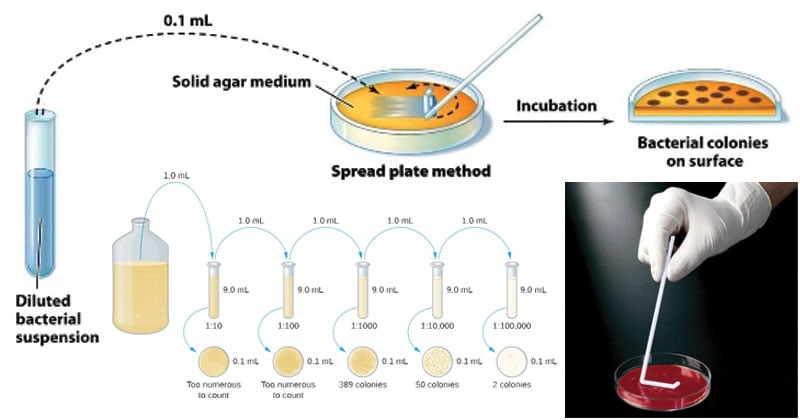Describe the Three Techniques Scientists Use to Preserve Bacterial Cultures
EMB agar is a medium used in the identification and isolation of pathogenic bacteria. Test the hypothesis with further.

Pdf Novel Preservation Techniques For Microbial Cultures
Propose a hypothesis to explain observations.

. Restriction enzymes which are bacterial proteins able to cut DNA at very specific places. No eating or drinking in the lab. The control sample is the thin glass disc.
Infectivity assays require cell cultures embryonated eggs or animals or plants or bacteria. How to Culture Bacteria Steps. Bacterial growth can spoil the milk.
Each distinct circular colony should represent an individual bacterial cell or group that has divided repeatedly. Plaque assays are a common type of infectivity assay. Quadrant streaking is mostly done to obtain pure colonies.
Three tools that made that growth possible emerged from research on sometimes obscure bacteria. Define describe each of the following as they apply to microbiology. The following mixing proportions make enough nutrient agar to prepare two halves of the Petri dish.
Includes incineration burning boiling and cooking. List and describe the sequence steps routinely used to identify bacteria. The use of mild heat to reduce the number of bacteria in.
For any bacteria culture experiment one must use the control sample which should exhibit known behaviour in terms of bactericidal behaviour. The importance of bacteria to humans Bacteria in food. It contains digested meat proteins as a source of organic nutrients.
The streak plate is a qualitative isolation method. Milk is an excellent growth medium for numerous bacteria and the bacteria can increase rapidly in numbers unless the milk is properly processed. Steps in the Scientific Method.
Learn how bacteria affect food storage and revise how we study and apply our knowledge of microbial growth. The application of heat to kill bacteria. This is true both in the environment and in and on our bodies.
To prevent lab microorganisms from being spread in the environment andor infecting the. To transfer cultures from one medium by inoculating another medium. These are referred to as the five Is in your text.
There is a great deal of variation in the specific techniques scientists use explore the natural world. The inoculation of the culture is made on the agar surface by back and forth streaking with the inoculation loop over the solid agar surface. One of the most common methods of transport for bacteria is with the aid of flagella thin whip-like structures that extend from the cell walls of many kinds of bacteria.
A scientist from the Louisiana State University Wildlife Hospital will also be joining the expedition to determine whether deep-water fishes from a relatively pristine environment harbor bacteria that are resistant to antibiotics routinely used by medical and veterinary health professionals. An infectivity assay measures particles capable of replicating in a particular cell type or animal. Next plasmid DNA containing the foreign DNA is mixed with the competent bacteria and the solution is heated.
To isolate a microorganism from a mixed culture to obtain a pure culture. These swollen bacteria are then known as competent bacteria. And cleaned by ethanol.
T4 DNA ligase a protein made from a bacterial virus that can be used to stick pieces of DNA together. Milk from a healthy cow initially contains very few bacteria which primarily come from the skin of the cow and the procedures for handling the milk. Not growing microorganisms at body temperature.
Some bacteria have a single tail-like flagellum or a small cluster of flagella which rotate in coordinated fashion much like the propeller on a boat engine to push the organism forward. Before transformation bacteria are treated with a chemical called calcium chloride which causes water to enter into the cells and makes them swell. Wiping bench with disinfectantalcohol.
This indicates how strong in your memory this concept is. Most bacterial colonies appear white cream or yellow in color and fairly circular in shape. But one type of bacteria called Clostridium sporogenes may actually be used to deliver drugs in cancer therapy thanks to its ability to.
Estimated 9 mins to. There are a variety of ways to kill bacteria or keep it from reproducing. From your lab tray or bench get a clean microwave-safe container quart-sized bowl to mix and heat the agar with water.
Two indicator dyes eosin and methylene blue inhibit the growth of gram-positive bacteria and distinguish between lactose fermenting and nonlactose fermenting organisms. Now the samples are rinsed in 1X PBS. Most of the currently known species of bacteria have been identified using traditional microbiological techniques such as the gram stain reaction morphology and metabolic reactions.
However the following steps characterize the majority of scientific investigations. To prevent contamination of cultures and media from microbes in the environment. Mix ½ teaspoon agar about 12 grams with ¼ cup 60 ml hot water and stir.
Using sterile loops when transferring cultures. Bacteria rarely live alone but in communities with other bacteria. Being kept in one place the resulting cells have accumulated to form a visible patch.
This will make a dilution gradient across the agar plate. And plasmids circles of DNA that replicate in bacteria and that can be. This is called subculturing.

Bacterial And Fungal Preservation Methods


0 Response to "Describe the Three Techniques Scientists Use to Preserve Bacterial Cultures"
Post a Comment